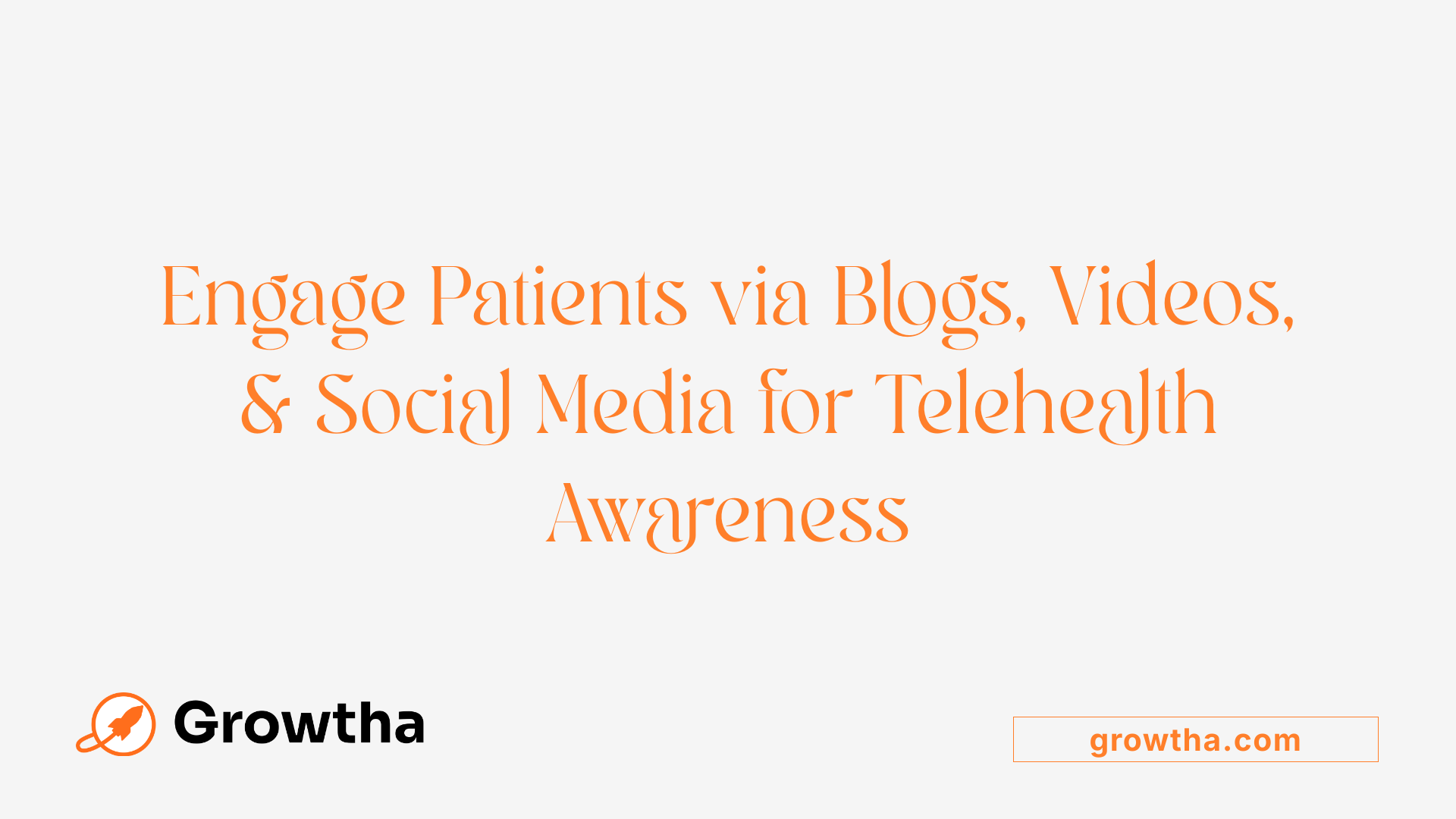Content Marketing for Telehealth Services
Harnessing Content for Telehealth Growth in a Digital Age


Content Marketing for Telehealth Services
Introduction to Content Marketing in Telehealth
The surge in telehealth adoption, accelerated by the COVID-19 pandemic, underscores the essential role of targeted content marketing strategies in fostering trust, awareness, and patient engagement. Developing compelling, educational, and accessible content helps healthcare providers distinguish their services, address patient concerns, and expand their reach in a competitive digital landscape.
The Purpose and Impact of Content Marketing in Healthcare

What is the purpose of content marketing in healthcare?
Content marketing in healthcare plays a vital role in educating and informing patients about various health conditions, treatment options, and wellness strategies. By providing accessible, well-researched, and relevant information through blogs, videos, infographics, and social media, healthcare providers empower patients to make informed decisions about their health.
One of the main goals is to establish healthcare organizations as trusted authority figures in the field. When providers regularly share valuable insights and educational content, they build credibility and foster trust among their community. This trust encourages existing patients to stay engaged and new patients to seek their services.
Furthermore, content marketing enhances online visibility. With targeted SEO strategies, relevant keywords, and engaging digital content, healthcare providers can improve their search engine rankings. This increased online presence helps attract potential patients who are searching for health services nearby.
Beyond attracting new patients, content marketing helps in nurturing long-term relationships. Consistent communication through informative newsletters, blogs, and social media keeps current patients connected. It also promotes preventive care and wellness activities, supporting overall patient health.
In summary, content marketing in healthcare aims to educate the public, build provider credibility, boost digital visibility, and foster ongoing patient relationships. Through strategic content, healthcare organizations can improve health literacy, increase patient trust, and ultimately, enhance the quality of care delivered.
Strategic Foundations of Telehealth Content Marketing
 Establishing thought leadership is essential for healthcare providers aiming to build trust and authority in the rapidly evolving field of telehealth. By creating educational content such as blog posts, whitepapers, case studies, and videos, providers can demonstrate the tangible benefits of telehealth—improved patient outcomes, increased access, enhanced efficiency, and streamlined workflows.
Establishing thought leadership is essential for healthcare providers aiming to build trust and authority in the rapidly evolving field of telehealth. By creating educational content such as blog posts, whitepapers, case studies, and videos, providers can demonstrate the tangible benefits of telehealth—improved patient outcomes, increased access, enhanced efficiency, and streamlined workflows.
One of the first steps in developing an effective telehealth marketing plan involves aligning content with the patient journey. Understanding common patient concerns and decision points allows content creators to develop targeted materials that answer questions, dispel fears, and showcase benefits like convenience, safety, and privacy.
Identifying the specific needs and priorities of the target audience is crucial. For example, some patients may value quick access and convenience, while others might look for management of chronic conditions. Tailoring messaging to these needs makes content more relevant and engaging.
Creating high-quality educational content is a cornerstone. Blogs that include guides, FAQ sections, instructional videos, and health tips can educate patients about what telehealth is, how it works, and the types of conditions treated. Content marketing not only educates but also improves search engine visibility, enabling providers to attract more prospective patients.
Moreover, content should reflect compliance with telehealth regulations, such as the 7-day rule for communications. This rule states that telehealth interactions should not be related to a medical visit that occurred within seven days and should not initiate a follow-up within the next 24 hours or the earliest available appointment. Including clear explanations about such guidelines fosters transparency and trust.
To maximize impact, combining content marketing with strategic digital and social media promotion enhances outreach. Regular blog updates, social media engagement, and targeted email campaigns help build ongoing relationships and convert interest into active use. Metrics such as website traffic, engagement rates, and patient inquiries should be continuously monitored to refine strategies.
Overall, a well-structured telehealth content marketing approach, rooted in understanding patient needs and regulatory considerations, supports the growth of telehealth services and strengthens a provider’s position as a trusted leader in digital healthcare.
Creating Trust Through Educational Content and Success Stories

How can telehealth providers build trust and visibility through content marketing?
Building trust and increasing visibility in telehealth services largely depends on effective content marketing strategies. Providers should focus on creating and sharing educational, transparent, and engaging content that directly addresses patient concerns and questions.
Patient testimonials and success stories play a vital role. These humanize the services, allowing new and potential patients to see real-world benefits and positive experiences. Sharing insights from healthcare experts further enhances credibility, demonstrating that the provider is knowledgeable and trustworthy.
Visual content such as infographics and videos not only make information more digestible but also improve engagement and shareability across social media platforms and search engines. Strategically distributing this content on channels most frequented by the target audience — like Facebook, Instagram, YouTube, and Google — expands reach.
Optimizing all content for SEO and local search terms, such as staples like "telehealth services near me," helps increase online visibility. Regular content updates, including blog posts, FAQs, and educational articles, maintain high search rankings and inform patients about the latest in telehealth.
Monitoring analytics helps providers understand what content resonates most, allowing continuous refinement. Overall, delivering high-quality, relevant content that fosters two-way communication and actively engages patients builds lasting trust, positions telehealth providers as reliable experts, and boosts patient confidence and service adoption.
Optimizing Digital Channels for Telehealth Promotion
How do I get more telehealth clients?
Attracting more telehealth clients requires a strategic approach to digital marketing. First, focus on website optimization and search engine optimization (SEO). A well-designed, user-friendly website that clearly highlights your telehealth services can make a significant difference. Incorporate compelling copy, easy navigation, and straightforward appointment booking options. Using relevant keywords related to telehealth services and local SEO tactics can help your site rank higher in search results, making it easier for potential patients to find you.
Next, leverage social media platforms effectively. Engage your audience with educational content, success stories, and interactive posts tailored to the platforms your target demographic uses most—like Facebook, Instagram, YouTube, or TikTok. Regular interaction builds trust and demonstrates your expertise.
Paid advertising campaigns are another crucial component. Platforms like Google Ads, Facebook Ads, and Google Performance Max campaigns allow you to target high-intent audiences precisely. Use targeted keywords and retargeting strategies to re-engage website visitors who didn’t convert initially.
Email marketing remains a low-cost, high-impact tool. Send regular newsletters, updates about your telehealth services, and personalized messages to nurture leads. Encourage satisfied patients to leave reviews on Google My Business, health directories, and review sites, which enhances credibility and attracts new clients.
Combining these digital strategies with traditional community outreach—such as partnering with local organizations and healthcare providers—can further expand your reach.
In summary, a multi-channel digital marketing plan focused on improving online visibility, engaging through social media, utilizing paid ads, and nurturing leads via email can significantly increase telehealth client numbers. Consistency, transparency, and high-quality content will help you build lasting trust and grow your practice.
This comprehensive approach aligns with research indicating that optimizing digital outreach is essential for expanding telehealth services in a competitive landscape.
Content Types and Channels for Telehealth Awareness
 To effectively promote telehealth services, healthcare providers utilize a diverse range of content types and channels aimed at educating and engaging current and potential patients.
To effectively promote telehealth services, healthcare providers utilize a diverse range of content types and channels aimed at educating and engaging current and potential patients.
Blogs and articles serve as foundational tools for content marketing. They provide detailed insights into telehealth benefits, such as increased access and convenience. For example, blogs titled 'What Is Telehealth?' or 'How Telehealth Works' help demystify the technology, answer common patient questions, and build trust. Alongside educational posts, organizations often publish success stories and case studies that demonstrate real-world benefits, thereby illustrating the positive impact telehealth can have on patient outcomes.
Videos and webinars are highly effective formats for visual storytelling. Demonstrations of how to use telehealth platforms, patient testimonials, and expert interviews are shared via platforms like YouTube, Facebook, and embedded on provider websites. These formats offer an engaging way to showcase ease of use, privacy measures, and safety features, helping to alleviate patient concerns and encourage service adoption.
Patient testimonials play a significant role in building credibility. When real patients share their positive experiences with telehealth, it fosters trust among prospective users. Testimonials can be presented as short videos, written stories, or social media posts, highlighting how telehealth conveniently managed their health needs while maintaining safety and comfort.
Social media campaigns are pivotal for outreach and community engagement. Targeted posts on Facebook, Instagram, TikTok, and LinkedIn utilize tailored content such as infographics, quick tips, live Q&As, and promotional offers. Consistent interaction through comments, shares, and live sessions helps build a community around telehealth services, promoting awareness and trust.
A comprehensive marketing approach combines these content types across multiple digital channels. This strategy ensures that messages about telehealth are accessible, relatable, and aligned with patient needs. Monitoring engagement metrics and feedback allows organizations to refine their content, making it more relevant and effective.
Content marketing efforts in telehealth are exemplified by organizations such as Cleveland Clinic and Mayo Clinic, which utilize high-quality, patient-focused content to demonstrate the benefits of virtual care. Strategies include targeted email campaigns, organic social media outreach, and paid ads. Rural providers also leverage local media, community partnerships, and internal staff training programs to reach underserved populations. Overall, a well-rounded content marketing plan—centered on patient education, trust-building, and community engagement—boosts telehealth adoption and helps overcome barriers like privacy concerns and unfamiliarity with technology.
Building Visibility and Trust Through Targeted Content and Partnerships

How can telehealth providers build trust and visibility through content marketing?
Building trust and increasing visibility are crucial for telehealth providers aiming to expand their patient base. An effective strategy involves creating educational, transparent, and engaging content that answers common patient questions about telehealth services, privacy concerns, and the benefits of virtual care. Sharing real patient testimonials and success stories humanizes the services, making new patients more comfortable and confident in choosing telehealth options.
Visual content such as infographics, videos, and step-by-step guides further enhance understanding and engagement. This type of content not only simplifies complex health topics but also appeals to diverse learning preferences. Distributing these materials strategically on platforms like social media, search engines, and local online directories helps increase reach.
Optimizing all content for search engines through relevant keywords, especially focus terms like "telehealth services near me" or "virtual healthcare in [location]," ensures better ranking in local search results. Regularly updating content and analyzing engagement metrics enable providers to refine their approach, ensuring they meet patient needs and improve visibility.
Furthermore, forming partnerships with local community organizations, social service agencies, and faith-based groups can expand outreach efforts. These collaborations help disseminate information through trusted channels, fostering credibility and familiar faces in the community.
In addition, engaging with local media—newspapers, radio stations, and community newsletters—can amplify the message further. Tailoring messaging for specific demographics, whether targeting seniors, rural populations, or working professionals, ensures that communication resonates effectively.
By combining these content marketing techniques with community-focused outreach and strategic partnerships, telehealth providers can build lasting trust, raise awareness, and become recognized leaders in virtual healthcare delivery.
Measuring Success and Continuous Improvement in Telehealth Content Strategy
To effectively gauge the impact of telehealth marketing efforts, healthcare providers must rely on various performance metrics and evaluation tools. These indicators help determine whether the strategies are meeting organizational goals and patient needs.
Performance Metrics include website traffic, engagement rates on social media, email open and click-through rates, and conversion rates such as appointment bookings through digital channels. Monitoring these helps identify what content or campaigns resonate most with the target audience.
Patient engagement analytics involve tracking how patients interact with telehealth platforms and content. This includes data such as time spent on telehealth pages, participation in webinars or educational videos, and feedback collected through surveys or patient portals. High engagement levels often correlate with increased trust and utilization.
Feedback mechanisms are vital for continuous improvement. Collecting patient reviews, conducting satisfaction surveys, and encouraging direct feedback provides insights on what works well and areas needing enhancement. Tools like the Telehealth Usability Questionnaire and Net Promoter Score (NPS) can quantify patient satisfaction and loyalty.
Iterative content refinement is a core element of maintaining an effective telehealth marketing strategy. Analyzing collected data enables providers to adjust their messaging, optimize content formats, and improve overall user experience. For instance, if a particular type of blog post garners high engagement, similar topics can be expanded.
How can telehealth service outcomes be evaluated?
Telehealth services can be assessed comprehensively using multiple measures that look at access, effectiveness, safety, patient experience, and financial impact. Frameworks such as the National Quality Forum (NQF) and the Supporting Pediatric Research on Outcomes and Utilization of Telehealth (SPROUT) provide guidance on relevant indicators.
Outcome measures include clinical health indicators like blood sugar levels for diabetic patients, vaccination rates, and emergency visit rates post-telehealth consultation. Utilization statistics, such as the number of virtual visits and claims data, offer insights into service adoption. Patient safety metrics track adverse events or complications following telehealth interventions.
Overall, combining quantitative data, such as clinical outcomes and usage stats, with qualitative feedback from patients and providers fosters a comprehensive approach to evaluating and improving telehealth services.
Conclusion: Building a Future of Trust and Engagement in Telehealth
Effective content marketing is pivotal in expanding telehealth adoption, establishing provider authority, and fostering trust in digital healthcare. By developing targeted, educational, and engaging content tailored to patient needs and local contexts, healthcare organizations can enhance visibility, improve patient satisfaction, and drive sustained growth. Continuous measurement, iterative refinement, and strategic partnerships further strengthen these efforts, creating a resilient platform for telehealth’s future success. In an increasingly connected world, content marketing remains an indispensable tool to transform healthcare delivery, making quality care accessible, trusted, and patient-centered.
References
- The Right Healthcare Content Marketing Strategy for Telehealth
- Marketing Considerations for Telehealth Programs - RHIhub Toolkit
- Boost Your Telehealth Service with an Easy Marketing Strategy
- [PDF] MARKETING YOUR TELEHEALTH PROGRAM
- Marketing for Telemedicine: Innovative Approaches for Modern ...
- What Can Digital Marketing Do for Your Telehealth Service?
- How To Launch Your Telehealth Marketing Campaign In Six Easy ...
- Telehealth Marketing: Proven Strategies & Tactics - Viseven







